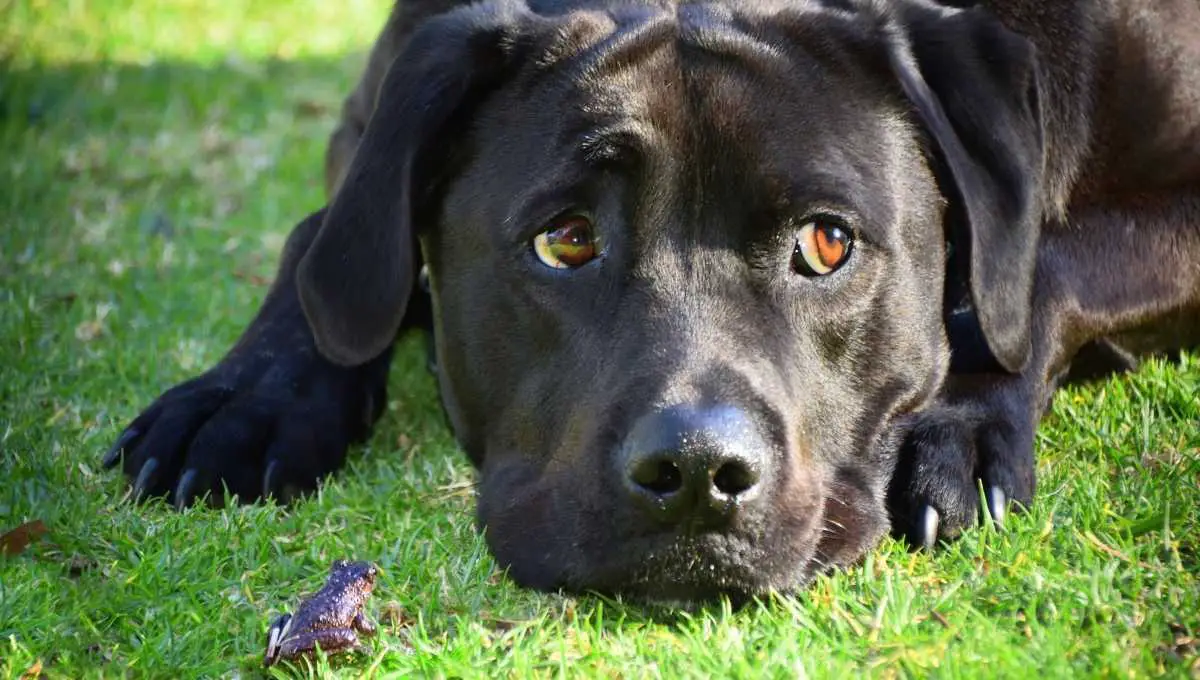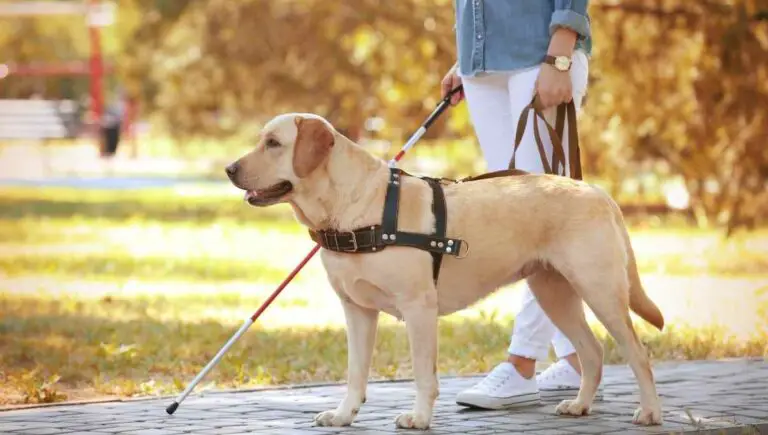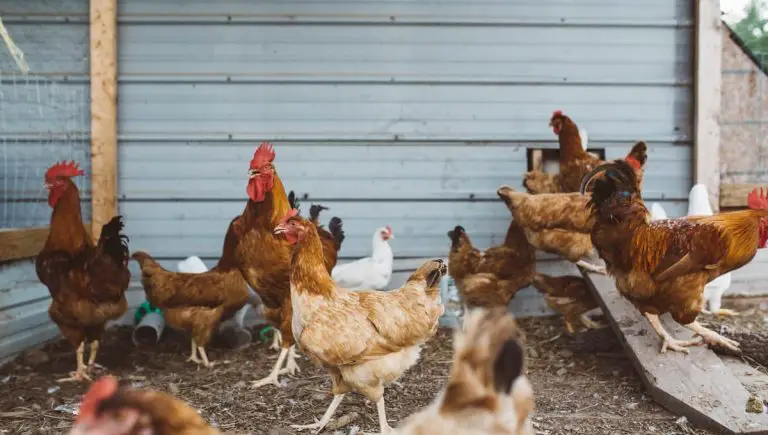Your Dog Ate a Dead Frog?: Do this Immediately!

What our dogs choose to eat and put in their mouths can sometimes surprise us. What do you do when you find out your dog just ate a dead frog, though?
If your dog ate a dead frog, observe them closely for signs of illness such as vomiting, loss of appetite, and foaming at the mouth. Using a clean moist cloth, gently wipe your dog’s gums and mouth clean of the frog’s toxins. If symptoms worsen, take your dog to the vet immediately.
Your dog’s reaction to eating a dead frog will most likely depend on the type of frog it ate. In this blog post, we’re going to show you how to know whether or not your dog has been poisoned, and what to do if your dog gets sick from eating a dead frog.
This post contains affiliate links from Amazon and other stores. This means Yard Blogger may earn a commission if you make a purchase using any of our links. Please refer to our full affiliate disclosure policy for full details.
Here’s a Quick Pro Tip!
One great way to prevent your dog from getting the chance to eat a dead frog when on walks is using something like the TUG 360° Tangle-Free, Heavy Duty Retractable Dog Leash to keep them away from dangerous things.
Alternatively, another safe option would be the Gentle Muzzle Guard for Dogs which won’t allow them to eat dead animals. You can pick up both of these over at Amazon.
Can a Dead Frog Hurt a Dog?
This would likely be your first question if you found out that your dog ate a dead frog. So, does eating a dead frog hurt your dog? The short answer is no, a dead frog won’t hurt your dog, but the same thing cannot be said of toads.
For this reason, it’s essential to know the difference between toads and frogs, as the former is more dangerous for your dog.
One difference to note is that frogs have slimy skin and are usually found near bodies of water. Meanwhile, toads have bumpy, rough skin and tend to explore the land, which is why they’re more likely to end up in your yard.
Toads and frogs secrete toxins from their skin as a defense mechanism. Depending on the species, symptoms of toad or frog poisoning will vary.
If you’re somewhere in the northern United States, you might encounter lethal species of toads, which is why you should be careful about letting your dog loose outdoors.
While most dogs will do alright if they’ve just eaten a frog, an owner can’t help but worry. You might notice some minor irritation around your dog’s mouth, even if he ate a non-poisonous frog, but that’s not much of a concern.
However, if you want to make sure nothing bad happens, visiting your vet may be a good idea.
My Dog Ate a Frog What to Do?
Whether you caught your dog picking up a dead frog in his mouth or you just found out when he presented the dead animal to you as a “gift,” you should be prepared to deal with this. You need to identify whether it was a poisonous or non-poisonous species.
If you’re not sure what you’re dealing with, you can contact your veterinarian, and together, you should be able to come up with a conclusion. You can also monitor your dog closely for any sign of illness.
If your dog didn’t react negatively, then the frog was most likely harmless.
If you want to be on the safer side and have some peace of mind, you can also bring your dog to the vet to confirm the frog species and let your dog receive appropriate treatment.
My Dog Ate a Toad
On the other hand, what if something more serious happens and your dog ate a toad instead? A situation like this requires emergency care, as toads can be lethal.
The two toad species common in the U.S are the cane toad and Colorado River toad. Both species can be found in Arizona, Colorado, Florida, Hawaii, and Texas.
If you suspect your dog just put a toad in his mouth, the best thing to do before rushing them to the vet is to gently wipe your dog’s mouth clean with a moist cloth to clean away the poisonous toxins.
Some people may try flushing or rinsing your dog’s mouth with water. Don’t do this, as your dog could swallow the toxin water or breath it in, giving them pneumonia. Wiping their gums and mouth with a clean cloth should suffice.
Having a quick response to poisoning is crucial if you want your dog to be safe.
You can also bag the dead frog and take it to your vet for proper identification. Doing so should help the vet come up with a plan on how to treat the poisoning.
Once you arrive at the vet clinic, understand that the doctor’s treatment plan may vary according to what and how bad the symptoms are. Your dog may be given certain medications to address the side effects of toad poisoning.
You might also enjoy our post on My Dog Ate a Dead Squirrel in the Yard
What Should I Do If My Dog Eats a Dead Animal
If your dog eats a dead animal, you should call your local vet immediately. Make sure to provide them with as much detail as possible about what your dog ate, as well as any symptoms you notice your dog is showing.
Oftentimes when dogs eat dead animals, they could pick up diseases such as roundworm, which is a parasite that can live within your dog’s intestines.
When it comes to the health and safety of your furry friend, you can never be too careful. In most cases, your veterinarian will have you bring your dog into the clinic to treat them there and check for any diseases they may have picked up from eating the dead animal.
How to Stop Your Dog From Eating Frogs
Prevention is still better than cure. If you live in an area where toads or frogs are abundant, it helps to know how to prevent your dog from touching a dead animal in the first place. It all boils down to two things:
- Train your pet with the leave command
- Never leave your dog alone when walking
Training your dog with some basic commands will greatly help whenever you take them on walks. The “Leave It” command works to condition your dog to ignore items, especially during walks.
It also helps if you accidentally dropped something on the floor and you don’t want your dog to come running towards that item.
The ideal outcome is that your dog should wait for permission before picking up something that’s on the ground. Doing so keeps your dog perfectly safe when walking and helps curb your dog’s curious behavior.
There are also great resources on learning to train your dog with the “leave it” command.
On the other hand, if you don’t have the time and patience to train your dog, then make sure you’re present at all times during walks, especially at night.
Toads and frogs usually come out at night, so keep a close eye on your dog during those times. This means never leaving your dog unattended, even if it’s just letting them loose in your garden.
You might also enjoy our post on What to Do if Your Neighbor Tries to Poison Your Dog
Can Dogs Get Sick From a Dead Frog?
Aside from minor irritation, your dog can get sick just by eating a dead frog. But as mentioned, this will depend on the species of frog. In the case of a dead frog, there usually isn’t a reason to worry.
Let’s start with frogs. In most cases, dogs remain fine when they eat a dead frog – unless, of course, it’s the poisonous species. This usually happens if your dog stumbled upon an exotic species from your neighbor. But in general, there is less concern when frogs are involved.
But it’s a different story if your dog ate a dead cane toad since the poison can remain longer. From cane toad eggs to a dried-up dead toad, the poison is still there. So, if your dog ate a cane toad that died a while ago, know that there is a big chance that it can still cause severe symptoms.
The toxins in these toads break down relatively slowly. If you found one in your garden, make sure to keep it away from your dog by disposing of it properly. Bury it deep or toss it in the garbage.
Can Green Tree Frogs Kill Dogs?
Green tree frogs are commonly found in the central and southeastern United States. If you happen to live in that region, you might have encountered tree frogs during your dog walks. And it won’t be a surprise if your dog goes after them.
And if your concern involves your dog accidentally eating a tree frog, then know that nothing serious will happen. Maybe your dog might have a minor irritation or a simple gastrointestinal issue, but other than that, your dog will be fine since green tree frogs can’t kill dogs.
Are Garden Frogs Poisonous to Dogs?
If you have a lush garden, expect that frogs and toads will visit them. This only means that you have a healthy garden free from chemicals – which is usually a good thing. But that could also mean a chance for your dog to play with the amphibians and get poisoned.
To know whether frogs in your garden are poisonous or not can be tricky. One feature that does stand out is a frog’s bright color. Whenever you see one, assume that it’s dangerous to be on the safe side. Common garden frogs, on the other hand, are usually harmless.
However, when you see a toad, be prepared as they are automatically regarded as dangerous to your dog. For this reason, you need to bag the frog or toad that your has in its mouth, so your vet can help identify it and make appropriate management of the poisoning.
You might also enjoy our post on What to Do if Your Dog Eats a Dead Mouse
How Do I Know If My Dog Ate a Frog?
It would be a good thing if you caught your dog eating a frog. At least, that would give you an idea of how to approach the situation.
But what if you never saw your dog eat it? How would you know that it was the frog or toad that caused your dog to have signs and symptoms of poisoning?
The most apparent sign of frog or toad poisoning is if your dog is foaming at the mouth. This is a natural reaction of your dog’s body working to get rid of the toxin. Other signs and symptoms include vomiting, excessive drooling, and loss of appetite.
Can Frogs Cause Dogs to Foam at the Mouth?
While frogs cause fewer problems than toads, you may still see subtle signs of irritation. If your dog ate a frog, foaming at the mouth can be expected. After all, frogs still have skin secretions that help protect themselves from predators.
The toxicity is not high, and in most cases, it’s tolerable, but foaming at the mouth could happen. Some dogs will do just fine, but some have foaming reactions. If this concerns you, it’s best to take your dog to the vet.
How Long Does It Take for a Dog to Show Signs of Toad Poisoning?
Symptoms of toad poisoning can show up within minutes after exposure. You may observe your dog salivating heavily and pawing at the mouth. These symptoms can progress later on to something more serious, such as falling, disorientation, and seizures.
If not treated promptly, your dog will eventually die. Once you observe your dog exhibiting these symptoms and you suspect poisoning, wash off their mouths with running water as you wait for your dog to be taken to the vet.
What Are the Side Effects of a Dog Eating a Frog?
The most common side effects that your dog will experience after eating a frog or toad are excessive drooling and foaming at the mouth. Watch out for these symptoms if you took your dog out for a walk or left your dog out in the garden to explore.
Drooling and foaming at the mouth signifies that your dog has eaten something that his body is rejecting. This could then be followed by vomiting and other gastrointestinal issues such as loss of appetite. Your dog may even whine from the discomfort.
My Dog Ate a Frog and Is Vomiting
Seeing your dog vomiting after eating a frog can be alarming. In that case, consult your veterinarian and go for an emergency appointment.
There is a better chance for your dog to get through this dangerous situation if treatment is given right away.
Conclusion: What Will Happen if a Dog Eats a Frog?
To sum up, dogs eating frogs (dead or alive) can be in for some trouble. Whether it’s severe or not will depend on what your dog has eaten. Frogs and toads can be used interchangeably, but it’s good to know the difference between the two.
The general idea is that toads are more toxic and can cause lethal poisoning in dogs. Even toads that have been dead for a while can be poisonous enough to harm your dog.
On the other hand, if your dog ate a dead frog, they usually recover, but still, it can bring discomfort in some cases.
Regardless, dogs should be closely monitored if you suspect they may have toad/frog poisoning. Your first response should be washing your dog’s mouth with running water.
If symptoms become worse and you observe your dog in distress, take them to the vet immediately.






